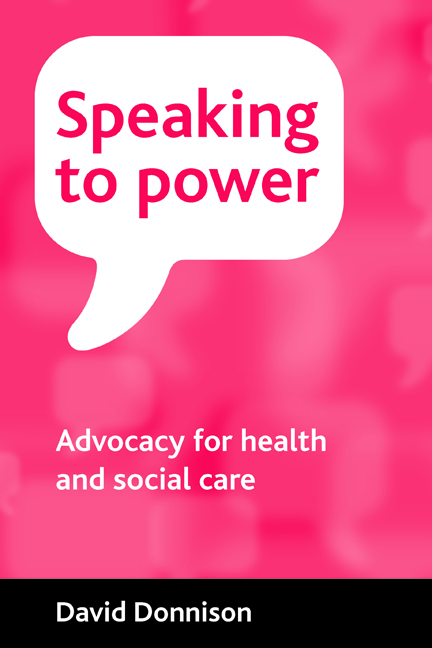Book contents
- Frontmatter
- Dedication
- Contents
- Why and how we wrote this book
- Introduction
- one Origins of advocacy
- two Scotland gives a lead
- three What advocates do: their main clients
- four What advocates do: questions and dilemmas
- five Groups and communities
- six Setting up an advocacy project and running it
- seven Volunteers
- eight Making advocacy accountable
- nine Roadblocks
- ten Looking ahead
- Further reading
- Index
- Frontmatter
- Dedication
- Contents
- Why and how we wrote this book
- Introduction
- one Origins of advocacy
- two Scotland gives a lead
- three What advocates do: their main clients
- four What advocates do: questions and dilemmas
- five Groups and communities
- six Setting up an advocacy project and running it
- seven Volunteers
- eight Making advocacy accountable
- nine Roadblocks
- ten Looking ahead
- Further reading
- Index
Summary
This book is about advocacy – particularly, but not only, for people who have learning disabilities or mental health difficulties. The practical experience we will draw on comes mainly from Scotland where new and important things have been happening in this field. Here are two examples of the work we will be writing about.
The first is summed up in a big book – a Personal Care Plan, or ‘PCP’ in the jargon of social work and community nursing. Prepared by an advocate, with help from colleagues in other services, this book is packed with words, pictures, medical prescriptions, names and addresses. It speaks for a young woman – let's call her Sandra – in her mid-twenties.
Sandra has stunted limbs and cannot walk, sit up or feed herself. It takes two people, using a specially made hoist, to lift her from a bed to a chair, or in and out of the swimming pool she visits regularly. She lives at home with her parents. Those who help them to care for her – 32 staff from 13 different agencies see her in a typical week – thought she was unable to speak or to understand anything they said. But her advocate, who works for a local agency, found by listening carefully to her and her parents that she has more than 20 words and sounds that have meanings that she understands pretty well. Indeed her grandmother, who has always loved her dearly, conducts long conversations with her in a language no one else quite understands. Sandra also has hopes and fears, friends she likes to be with, and ambitions for the future.
Her personal care plan explains these and many other things: the foods she can and cannot eat, the movements that hurt her, the medicines she needs and much else. It shows, with photographs, how to lift and move her, and how to take her for a swim.
Equally important, it has brought together 32 nurses, social workers and professional carers – most of whom had never met before – and helped them to get to know each other and to agree on the best ways to help Sandra achieve the things she wants to do.
- Type
- Chapter
- Information
- Speaking to PowerAdvocacy for Health and Social Care, pp. 1 - 6Publisher: Bristol University PressPrint publication year: 2009

